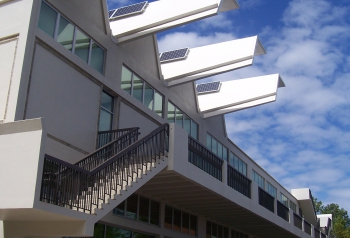
Originally constructed in 1962 to house The University of Georgia's visual arts program, the Jackson Street Building's modernist facade has always been prominent amongst the neo-classical Georgian architecture that predominates campus. After five decades of use, the building has been newly modernized with state of the art LEED features. Re-opened in 2012 following a complete interior renovation, the new facility is on track for LEED Gold in New Construction and Major Renovations. As the new headquarters for UGA's College of Environment and Design, the building contains administrative offices, lecture halls and studio space, a gallery, and the Owens Library. The University placed a high priority on using the most low-impact and sustainable methods possible in the construction of their new facility. The building is a manifestation of UGA's environmental values and an educational tool for students and the community.
